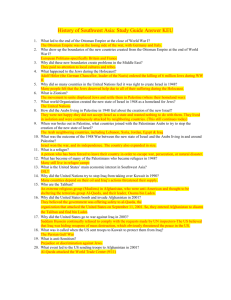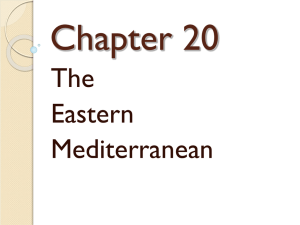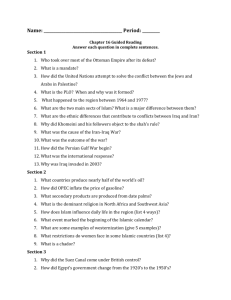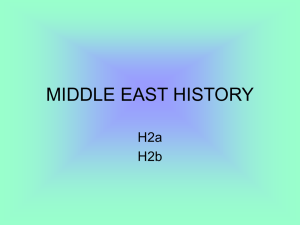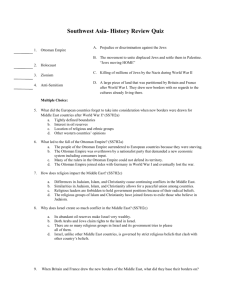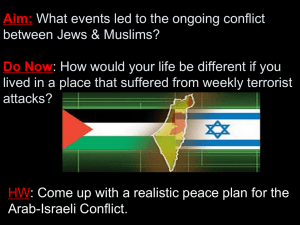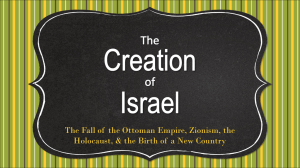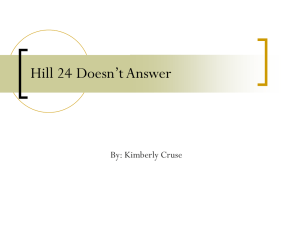Historical Understanding Middle East
advertisement
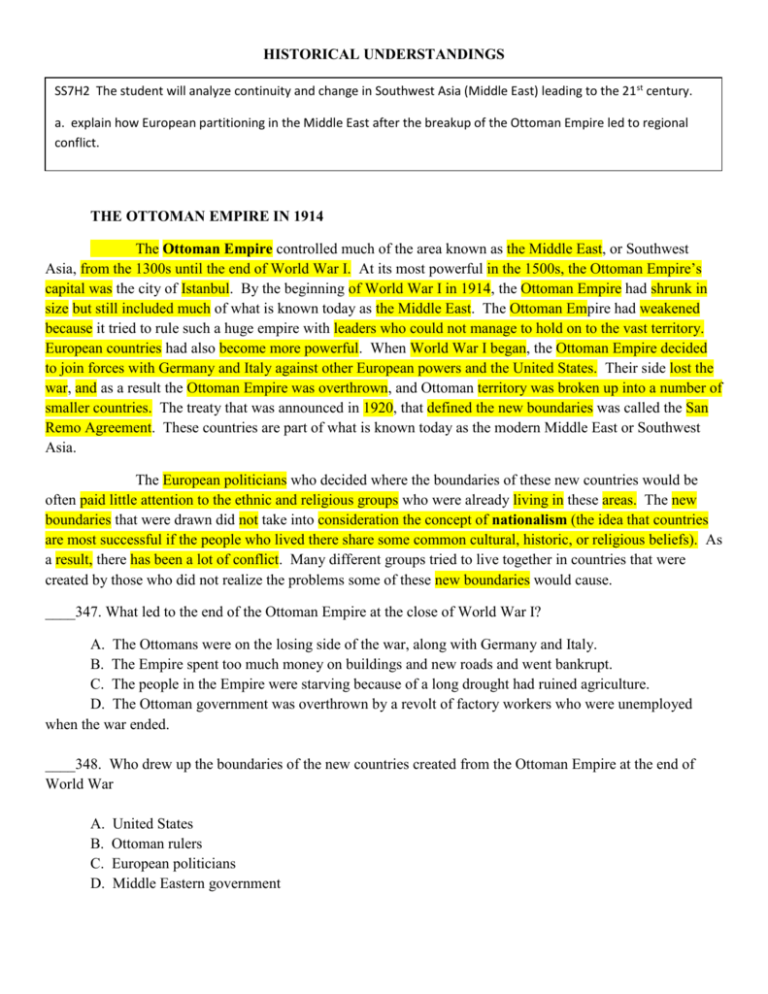
HISTORICAL UNDERSTANDINGS SS7H2 The student will analyze continuity and change in Southwest Asia (Middle East) leading to the 21st century. a. explain how European partitioning in the Middle East after the breakup of the Ottoman Empire led to regional conflict. THE OTTOMAN EMPIRE IN 1914 The Ottoman Empire controlled much of the area known as the Middle East, or Southwest Asia, from the 1300s until the end of World War I. At its most powerful in the 1500s, the Ottoman Empire’s capital was the city of Istanbul. By the beginning of World War I in 1914, the Ottoman Empire had shrunk in size but still included much of what is known today as the Middle East. The Ottoman Empire had weakened because it tried to rule such a huge empire with leaders who could not manage to hold on to the vast territory. European countries had also become more powerful. When World War I began, the Ottoman Empire decided to join forces with Germany and Italy against other European powers and the United States. Their side lost the war, and as a result the Ottoman Empire was overthrown, and Ottoman territory was broken up into a number of smaller countries. The treaty that was announced in 1920, that defined the new boundaries was called the San Remo Agreement. These countries are part of what is known today as the modern Middle East or Southwest Asia. The European politicians who decided where the boundaries of these new countries would be often paid little attention to the ethnic and religious groups who were already living in these areas. The new boundaries that were drawn did not take into consideration the concept of nationalism (the idea that countries are most successful if the people who lived there share some common cultural, historic, or religious beliefs). As a result, there has been a lot of conflict. Many different groups tried to live together in countries that were created by those who did not realize the problems some of these new boundaries would cause. ____347. What led to the end of the Ottoman Empire at the close of World War I? A. The Ottomans were on the losing side of the war, along with Germany and Italy. B. The Empire spent too much money on buildings and new roads and went bankrupt. C. The people in the Empire were starving because of a long drought had ruined agriculture. D. The Ottoman government was overthrown by a revolt of factory workers who were unemployed when the war ended. ____348. Who drew up the boundaries of the new countries created from the Ottoman Empire at the end of World War A. B. C. D. United States Ottoman rulers European politicians Middle Eastern government SS7H2 The student will analyze continuity and change in Southwest Asia (Middle East) leading to the 21st century. b. Explain the historical reasons for the establishment of the modern State of Israel in 1948; include the Jewish religious connections to the land, the Holocaust, anti-Semitism, and Zionism in Europe. One of the areas created from the old Ottoman Empire at the end of World War I was Palestine. This area was important to the Jews, Christians and Muslims because this is where much of what is written in the Old Testament, the New Testament and the Quran took place. There are many religious sites in Palestine sacred to all three religions. The most important of these is Jerusalem. In the years before World War II, Palestine was divided again into Transjordan, on the eastern side of the Jordan River, and an area still known as Palestine on the western side of the river. The British were given the responsibility for ruling in Palestine until a decision could be made about how to establish a permanent government there. Most of the people living in Palestine before World War II (WWII) were Palestinian Arabs. However, since the late 1800’s large number of Jewish settler had been immigrating to the area from both Western and Eastern Europe. Some of these Jewish settlers had wanted to create a homeland for the world’s Jews in Palestine, because they believed land in this area had been promised to them by God many thousands of years ago, as told in the stories of the Old Testament. These groups were known as Zionists (those who felt the world’s Jews deserved to return to a homeland in Zion, or those parts of Palestine where the Jewish people had lived in Biblical times). Conflicts began to break out between the settlers and the Palestinian Arabs, as each group tried to hold onto the land. During WWII, the Jewish people in Europe suffered terribly at the hands of the Nazi government of Germany. There was widespread anti-Semitism (hatred of the Jews simply because they practiced the Jewish faith) in Europe. Over six million European Jews were killed in concentration camps set up by Germany and many thousands of others had to leave Europe to avoid death. This terrible time came to be known as the Holocaust. At the end of the war, the Jewish people of the world want to take steps to be sure nothing like this could ever happen again. Many countries in the world felt tremendous guilt over the Holocaust as they began to learn the details of what had gone on in the German-run concentration camps. A number of Jewish groups living in Europe and the United States, even before the Holocaust, had talked of trying to set up a homeland for the Jewish people in the region of the Middle East or Southwest Asia known as Palestine. At the end of the war, the created United Nations also believed something should be done for the Jewish people because of their suffering. In 1948, the United Nations voted to create a homeland for the Jews in part of Palestine. The Jews who were living there accepted the offer and declared the creation of the State of Israel. However, not everyone was happy with this new state. There were Palestinian Arabs living in the area who felt the United Nations had unfairly given their land away, and they along with many other Arab countries refused to accept the new state. War broke out in May 1948 between the new state of Israel and the Palestinians. Other Arab countries in Southwest Asia agreed with the Palestinians. Other Arab countries in Southwest Asia agreed with the Palestinians and helped them during this war. The Israelis were able to win this war and the new state of Israel survived, taking over even more land than had originally been planned. ____349. Which describes the Holocaust? A. B. C. D. the murder of millions of European Jews during WWII the destruction of all European governments during WWII the bombing of towns and villages in England and Germany during WWII the Russian policy of burning ground behind them as they retreated to stop the German invasion ____350. Why did so many countries in the United Nations feel it was right to create Israel in 1948? A. B. C. D. There was no one else living on the land at that time. Many felt the Jews deserved help due to their suffering in the Holocaust. Arab countries in the area supported the creation of a homeland for the Jews in Palestine. All national groups in the former Ottoman Empire were being given homelands at the same time. ____351. What is Zionism? A. B. C. D. the idea that all religious groups should have their own states the plan to let Arabs and Jews share the land in Palestine equally the hope that all governments will be based on religious principles. the belief that Jews deserved to return to a homeland in Zion where they had lived in Biblical times ____352. What world organization created the new state of Israel in 1948 as a homeland for the Jews? A. B. C. D. the United Nations the European Union the League of Nations the Organization of Petroleum Exporting Countries ____353. How did Arabs living in Palestine in 1948 feel about the creation of the new state of Israel? A. B. C. D. They supported it fully They rejected it as unfair to them. The Arab population in Palestine was largely unaffected by the new state. They agreed to try to work it out although they were unhappy about the decision. ____354. When war broke out in Palestine, what countries join with Palestinian Arabs to try to stop the creation of the new state of Israel? 34· The United States neighboring Arab countries the major nations of Europe the countries belonging to the United Nations LEBANON EGYPT 32° Use the map below to answer the next three questions. Golan Heights (Israeli occupied) A. B. C. D. 34· 355. Which countries border the Gaza Strip? SYRIA A. B. C. D. Iraq and Jordan Israel and Egypt Lebanon and Syria Israel and the West Bank 32° 356. What is the approximate location of the Dead Sea from Jerusalem? DEAD GAZA SEA STRIP JORDAN N 30° 30° A. B. C. D. nearly 25 miles east nearly 25 miles west about 15 miles southeast about 15 miles southwest 357. What country is found at 31° N, 34° E? A. B. C. D. Egypt Israel Jordan Saudi Arabia 34° SS7H2 The student will analyze continuity and change in Southwest Asia (Middle East) leading to the 21st century. c. Describe how land and religion are reasons for continuing conflicts in the Middle East. In May 1948, war broke out in Palestine between the Jews who supported the creation of the new state of Israel and the Palestinian Arabs who also lived there. The neighboring Arab countries supported Palestinian claims to land now in the new state of Israel. The Israelis were able to win this war and the new state of Israel survived, taking over even more land than had originally been planned. Many Palestinians became refugees (people who had to leave their homes as the result of the war). In the last 50 years, there have been additional wars between the Israelis and the Palestinians. Israel has continued to exist, and many of the Palestinians and their descendant still live in refugee camps or in parts of Israel that they feel should be a Palestinian state. The problems between these two people still exist, even though people on both sides of the conflict continue to look for ways to find peaceful solution to their disagreements. Arab countries in the area are strong supporters of the Palestinians, while the United States is a powerful supporter of the Israelis. The Arab-Israeli conflict plays a major role in the difficulties that the United states and the rest of the world face when trying to find peaceful settlements to the Southwest Asian, or Middle Eastern, conflicts. ____358. What was the outcome of the 1948 War between the new state of Israel and the Arab living in and around Palestine? A. The conflict ended and all Palestinian Arabs became citizens in the new State of Israel. B. Israel won the war and the new State of Israel was even larger than originally planned. C. Almost no Jewish people were willing to go to Israel because of the country’s angry Arabs neighbors. D. The United Nations decided to withdraw the proposal to create the State of Israel because of all the problems it caused in the area. ____359. What is a “refugee”? A. a person who had to leave their home as a result of war. B. a person who opens his home to those who need a safe place to stay C. a person who refuses to take in someone who is without a safe place to stay D. someone who refuses to leave his home even though it is dangerous to stay there ____360. What has become of many of the Palestinians who became refugees in 1948? A. Many still live in refugee camps. B. Most have become Israeli citizens. C. They have been given a state of their own in which to live. D. They have given up any claim to return to the land they lost in 1948. SS7H2 The student will analyze continuity and change in Southwest Asia (Middle East) leading to the 21st century. d. Explain U.S. presence and interest in Southwest Asia, include the Persian Gulf conflict, invasion of Afghanistan and Iraq. The United States has had significant political and economic interests in the Middle East since the 1800s, when merchants, missionaries, and tourists began to visit the region. In addition, vast supplies of oil are found in this area, oil that is critical to the United States’ energy supplies. Since the end of WWI, the United States has played an important role in the diplomacy following the break-up of the Ottoman Empire. The United States support for the creation of the state of Israel in 1948 also focused attend on this part of the world. In August 1990, the country of Iraq invaded Kuwait in an effort to control Kuwait’s large supplies of oil. The leader of Iraq, Saddam Hussein, claimed that Kuwait was taking more oil than they were allowed to from the shared oil fields. He also claim that when the Ottoman Empire was broken up at the end of WWI, the area that became the country of Kuwait should have been part of Iraq. The creation of the country of Kuwait in 1920 meant that Iraq no longer had any coastline on the Persian Gulf. The United States was concerned about the invasion because the U.S. gets a large portion of its imported oil from Kuwait and Saudi Arabia, another country in the Middle East. Kuwait belonged to the United Nations, a world organization which will come to the aid of a member nation that is attacked without cause by another country. The U.N. voted to raise a military force to liberate Kuwait from the Iraqi invasion. Because of the threat to the oil supply, the United States sent troop to be a part of this UN military force to drive Iraq out of Kuwaiti territory. This efforts was known as the Persian Gulf War or Operation Desert Storm. Thirty-nine countries joined in and within three months, by February 1991, the Iraqi government accepted a truce and agreed to withdraw from Kuwait. In 2001, after the destruction of the World Trade Center in New York City, the U.S. began a military operation in Afghanistan aimed at capturing the people responsible for the attack. Intelligence sources identified an organization known as Al-Qaeda, for the Force, as the group of terrorists that planned and carried out the attack. Its leaders were a man who was born in Saudi Arabia Osama bin-Laden. His family was very wealthy and he had used his money to finance this organization. One of the aims of Al-Qaeda is to bring about an end to western influence in the Middle East, or Southwest Asia. Sources in the U.S. government believed that the radical Muslim government of Afghanistan, the Taliban, allowed Al-Qaeda to hide in the mountains of their country. The U.S. launched a series of attacks on these mountain hideouts in October 2001, in an attempt to capture bin-Laden and destroy al-Qaeda. U.S. troops were also send in and the Afghanistan in an attempt to find bin-Laden and destroy his organization. The U.S. is still working to help the people of Afghanistan reorganize their government. In 2003, the U.S. launched an invasion of Iraq, after claiming that the Iraqi government led by Saddam Hussein, was developing nuclear weapons and offering to aid to nuclear weapons and offering aid to groups like al-Qaeda, who were a threat to the United States interests in the region. The United States called this military action Operation Iraqi Freedom. The government of Saddam Hussein collapsed quickly because man of the Iraqis also felt he was a cruel leader. However, problems followed as the United States did not have a plan ready to help reorganize the country one the old government were gone. American forces have remained in Iraq ever since, trying to stop the fighting between the different religious and ethnic groups who are competing with each other for power as they try to organize a new government.
